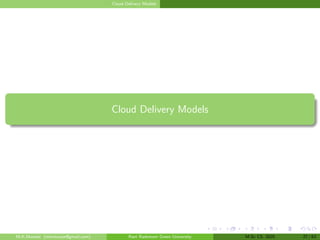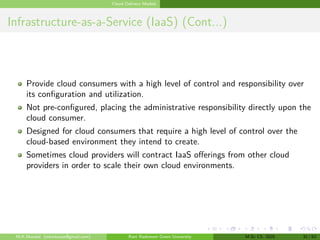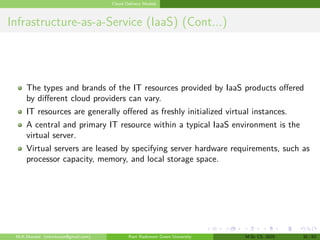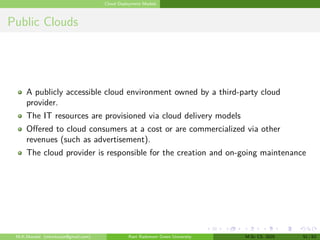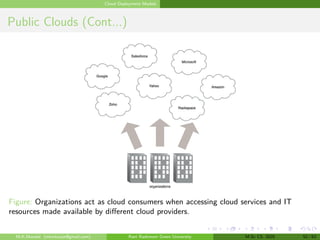Cloud Computing : Fundamental Concepts and Models
- 1. Fundamental Concepts and Models Manash Kumar Mondal Rani Rashmoni Green University Code: MSCCS401 M.K.Mondal ([email protected]) Rani Rashmoni Green University M.Sc CS. 2025 1 / 63
- 2. Contents 1 Roles 2 Boundaries 3 Cloud Characteristics 4 Cloud Delivery Models 5 Cloud Deployment Models M.K.Mondal ([email protected]) Rani Rashmoni Green University M.Sc CS. 2025 2 / 63
- 3. Roles Roles M.K.Mondal ([email protected]) Rani Rashmoni Green University M.Sc CS. 2025 3 / 63
- 4. Roles Cloud Provider Organisation, provides cloud-based IT resources. Responsible for making cloud services available to cloud consumers, as per agreed upon SLA guarantees. Management and administrative duties to ensure the on-going operation of the overall cloud infrastructure. Owns the IT resources that are made available for lease by cloud consumers ”Resell” IT resources leased from other cloud providers. M.K.Mondal ([email protected]) Rani Rashmoni Green University M.Sc CS. 2025 4 / 63
- 5. Roles Cloud Consumer An organisation (or a human) Has a formal contract or arrangement with a cloud provider Uses IT resources made available by the cloud provider. Uses a cloud service consumer to access a cloud service M.K.Mondal ([email protected]) Rani Rashmoni Green University M.Sc CS. 2025 5 / 63
- 6. Roles Cloud Provider and Cloud Consumer Figure: A cloud consumer (Organisation A) interacts with a cloud service from a cloud provider (that owns Cloud A). Within Organisation A, the cloud service consumer is being used to access the cloud service. M.K.Mondal ([email protected]) Rani Rashmoni Green University M.Sc CS. 2025 6 / 63
- 7. Roles Cloud Service Owners The person or organization that legally owns a cloud service Can be the cloud consumer, or the cloud provider that owns the cloud within which the cloud service resides. Cloud consumer organizations can develop and deploy cloud services in clouds owned by third parties for the purpose of making the cloud services available to the general public. M.K.Mondal ([email protected]) Rani Rashmoni Green University M.Sc CS. 2025 7 / 63
- 8. Roles Cloud Consumer As Cloud Service Owner Figure: A cloud consumer can be a cloud service owner when it deploys its own service in a cloud. M.K.Mondal ([email protected]) Rani Rashmoni Green University M.Sc CS. 2025 8 / 63
- 9. Roles Cloud Consumer As Cloud Service Owner Figure: A cloud provider becomes a cloud service owner if it deploys its own cloud service, typically for other cloud consumers to use. M.K.Mondal ([email protected]) Rani Rashmoni Green University M.Sc CS. 2025 9 / 63
- 10. Roles Cloud Auditor A third-party that conducts independent assessments of cloud environments The evaluation of security controls, privacy impacts, and performance. Provides an unbiased assessment (and possible endorsement) of a cloud environment to help strengthen the trust relationship between cloud consumers and cloud providers. M.K.Mondal ([email protected]) Rani Rashmoni Green University M.Sc CS. 2025 10 / 63
- 11. Roles Cloud Broker and Cloud Carrier Cloud Broker The responsibility of managing and negotiating the usage of cloud services between cloud consumers and cloud providers. Mediation services - inter-mediation, aggregation, and arbitrage. Cloud Carrier Provides the wire-level connectivity between cloud consumers and cloud providers. Network and telecommunication providers. M.K.Mondal ([email protected]) Rani Rashmoni Green University M.Sc CS. 2025 11 / 63
- 12. Boundaries Boundaries M.K.Mondal ([email protected]) Rani Rashmoni Green University M.Sc CS. 2025 12 / 63
- 13. Boundaries Organisational Boundary Represents the physical perimeter that surrounds a set of IT resources owned and governed by an organization. Does not represent the boundary of an actual organization, only an organisational set of IT assets and IT resources. Clouds have an organisational boundary. M.K.Mondal ([email protected]) Rani Rashmoni Green University M.Sc CS. 2025 13 / 63
- 14. Boundaries Organisational Boundary of Consumer and Provider Figure: Organizational boundaries of a cloud consumer (left), and a cloud provider (right), represented by a broken line notation. M.K.Mondal ([email protected]) Rani Rashmoni Green University M.Sc CS. 2025 14 / 63
- 15. Boundaries Trust Boundary When an organization assumes the role of cloud consumer to access cloud-based IT resources, it needs to extend its trust beyond the physical boundary of the organization to include parts of the cloud environment. A logical perimeter that typically spans beyond physical boundaries to represent the extent to which IT resources are trusted. When analysing cloud environments, it is most frequently associated with the trust issued by the organization acting as the cloud consumer. M.K.Mondal ([email protected]) Rani Rashmoni Green University M.Sc CS. 2025 15 / 63
- 16. Boundaries Trust boundary and Organisational Boundary Figure: An extended trust boundary encompasses the organisational boundaries of the cloud provider and the cloud consumer. M.K.Mondal ([email protected]) Rani Rashmoni Green University M.Sc CS. 2025 16 / 63
- 17. Cloud Characteristics Cloud Characteristics M.K.Mondal ([email protected]) Rani Rashmoni Green University M.Sc CS. 2025 17 / 63
- 18. Cloud Characteristics On-demand Usage A cloud consumer can autonomously access cloud-based IT resources Gives the cloud consumer the freedom to self-provision these IT resources Once configured, usage of the self-provisioned IT resources can be automated - no further human involvement. Also known as “on-demand self-service usage,” enables the service-based and usage-driven features found in mainstream clouds. M.K.Mondal ([email protected]) Rani Rashmoni Green University M.Sc CS. 2025 18 / 63
- 19. Cloud Characteristics Ubiquitous Access Represents the ability for a cloud service to be widely accessible. Require support for a range of devices, transport protocols, interfaces, and security technologies. To enable this level of access generally requires that the cloud service architecture be tailored to M.K.Mondal ([email protected]) Rani Rashmoni Green University M.Sc CS. 2025 19 / 63
- 20. Cloud Characteristics Multitenancy and Resource Pooling Multitenacy The characteristic of a software program that enables an instance of the program to serve different consumers (tenants) whereby each is isolated from the other, is referred to as multitenancy. A cloud provider pools its IT resources to serve multiple cloud service consumers by using multitenancy models Relies on the use of virtualization technologies IT resources can be dynamically assigned and reassigned, according to demands. M.K.Mondal ([email protected]) Rani Rashmoni Green University M.Sc CS. 2025 20 / 63
- 21. Cloud Characteristics Multitenancy and Resource Pooling cont. Resource Pooling Resource pooling allows cloud providers to pool large-scale IT resources to serve multiple cloud consumers. Different physical and virtual IT resources are dynamically assigned and reassigned according to demand Statistical multiplexing. Resource pooling is achieved through multitenancy technology M.K.Mondal ([email protected]) Rani Rashmoni Green University M.Sc CS. 2025 21 / 63
- 22. Cloud Characteristics Single-tenant vs Multitenat Environments Figure: Single-tenant: each cloud consumer has a separate IT resource instance. Figure: Multitenant: A single instance of an IT resource, such as a cloud storage device, serves multiple consumers. M.K.Mondal ([email protected]) Rani Rashmoni Green University M.Sc CS. 2025 22 / 63
- 23. Cloud Characteristics Elasticity The automated ability of a cloud to transparently scale IT resources, as required in response to runtime conditions or as pre-determined by the cloud consumer or cloud provider. Closely associated with the Reduced Investment and Proportional Costs benefit. Cloud providers with vast IT resources can offer the greatest range of elasticity. M.K.Mondal ([email protected]) Rani Rashmoni Green University M.Sc CS. 2025 23 / 63
- 24. Cloud Characteristics Measured usage Represents the ability of a cloud platform to keep track of the usage of its IT resources, primarily by cloud consumers. Based on what is measured, the cloud provider can charge a cloud consumer only for the IT resources actually used and/or for the time-frame during which access to the IT resources was granted. It is closely related to the on-demand characteristic. Not only tracking statistics for billing purposes. Also encompasses the general monitoring of IT resources and related usage reporting (for both cloud provider and cloud consumers) Measured usage is also relevant to clouds that do not charge for usage (Private Cloud) M.K.Mondal ([email protected]) Rani Rashmoni Green University M.Sc CS. 2025 24 / 63
- 25. Cloud Characteristics Resiliency A form of failover that distributes redundant implementations of IT resources across physical locations. IT resources can be pre-configured so that if one becomes deficient, processing is automatically handed over to another redundant implementation. Redundant IT resources within the same cloud (but in different physical locations) or across multiple clouds. Increase both the reliability and availability of their applications by leveraging the resiliency of cloud-based IT resources. M.K.Mondal ([email protected]) Rani Rashmoni Green University M.Sc CS. 2025 25 / 63
- 26. Cloud Characteristics An Example: Resiliency Figure: A resilient system in which Cloud B hosts a redundant implementation of Cloud Service A to provide failover in case Cloud Service A on Cloud A becomes unavailable. M.K.Mondal ([email protected]) Rani Rashmoni Green University M.Sc CS. 2025 26 / 63
- 27. Cloud Delivery Models Cloud Delivery Models M.K.Mondal ([email protected]) Rani Rashmoni Green University M.Sc CS. 2025 27 / 63
- 28. Cloud Delivery Models Cloud Delivery Models Represents a specific, pre-packaged combination of IT resources offered by a cloud provider. Three common cloud delivery models widely established and formalised: Infrastructure-as-a-Service (IaaS) Platform-as-a-Service (PaaS) Software-as-a-Service (SaaS) N.B A cloud delivery model can be referred to as a ’cloud service delivery model’ because each model is classified as a different type of cloud service offering. M.K.Mondal ([email protected]) Rani Rashmoni Green University M.Sc CS. 2025 28 / 63
- 29. Cloud Delivery Models Extended Cloud Delivery Models Many specialised variations of the three base cloud delivery models have emerged, each comprised of a distinct combination of IT resources. Storage-as-a-Service (STaaS) Database-as-a-Service (DBaaS) Security-as-a-Service (SECaaS) Communication-as-a-Service (CaaS) Integration-as-a-Service Testing-as-a-Service (TaaS) Process-as-a-Service Business Process-as-a-Service (BPaaS) M.K.Mondal ([email protected]) Rani Rashmoni Green University M.Sc CS. 2025 29 / 63
- 30. Cloud Delivery Models Infrastructure-as-a-Service (IaaS) IaaS A self-contained IT environment comprised of infrastructure-centric IT resources that can be accessed and managed via cloud service-based interfaces and tools. Environment may include Environment may include hardware, network, connectivity, operating systems, and other “raw”IT resources. vs. Traditional hosting or outsourcing environment IT resources are typically virtualized and packaged into bundles that simplify up-front runtime scaling and customization of the infrastructure. M.K.Mondal ([email protected]) Rani Rashmoni Green University M.Sc CS. 2025 30 / 63
- 31. Cloud Delivery Models Infrastructure-as-a-Service (IaaS) (Cont...) Provide cloud consumers with a high level of control and responsibility over its configuration and utilization. Not pre-configured, placing the administrative responsibility directly upon the cloud consumer. Designed for cloud consumers that require a high level of control over the cloud-based environment they intend to create. Sometimes cloud providers will contract IaaS offerings from other cloud providers in order to scale their own cloud environments. M.K.Mondal ([email protected]) Rani Rashmoni Green University M.Sc CS. 2025 31 / 63
- 32. Cloud Delivery Models Infrastructure-as-a-Service (IaaS) (Cont...) The types and brands of the IT resources provided by IaaS products offered by different cloud providers can vary. IT resources are generally offered as freshly initialized virtual instances. A central and primary IT resource within a typical IaaS environment is the virtual server. Virtual servers are leased by specifying server hardware requirements, such as processor capacity, memory, and local storage space. M.K.Mondal ([email protected]) Rani Rashmoni Green University M.Sc CS. 2025 32 / 63
- 33. Cloud Delivery Models Infrastructure-as-a-Service (IaaS) (Cont...) Figure: A cloud consumer is using a virtual server within an IaaS environment. Cloud consumers are provided with a range of contractual guarantees by the cloud provider, pertaining to characteristics such as capacity, performance, and availability. M.K.Mondal ([email protected]) Rani Rashmoni Green University M.Sc CS. 2025 33 / 63
- 34. Cloud Delivery Models Platform-as-a-Service (PaaS) PaaS A pre-defined “ready-to-use”environment typically comprised of already deployed and configured IT resources. Pre-packaged products and tools PaaS relies on the usage of a ready-made environment that establishes a set of pre-packaged products and tools used to support the entire delivery lifecycle of custom applications. M.K.Mondal ([email protected]) Rani Rashmoni Green University M.Sc CS. 2025 34 / 63
- 35. Cloud Delivery Models Platform-as-a-Service (PaaS) (Cont...) Reason for investing in PaaS environment Wants to extend on-premise environments into the cloud for scalability and economic purposes. Uses the ready-made environment to entirely substitute an on-premise environment. Wants to become a cloud provider and deploys its own cloud services to be made available to other external cloud consumers. M.K.Mondal ([email protected]) Rani Rashmoni Green University M.Sc CS. 2025 35 / 63
- 36. Cloud Delivery Models Platform-as-a-Service (PaaS) (Cont...) Pros. Spared from the administrative burden of setting up and maintaining the bare infrastructure IT resources provided via the IaaS model. Cons. Conversely, the cloud consumer is granted a lower level of control over the underlying IT resources that host and provision the platform. Examples Google App Engine offers a Java and Python-based environment. M.K.Mondal ([email protected]) Rani Rashmoni Green University M.Sc CS. 2025 36 / 63
- 37. Cloud Delivery Models Platform-as-a-Service (PaaS) (Cont...) Figure: A cloud consumer is accessing a ready-made PaaS environment. The question mark indicates that the cloud consumer is intentionally shielded from the implementation details of the platform. M.K.Mondal ([email protected]) Rani Rashmoni Green University M.Sc CS. 2025 37 / 63
- 38. Cloud Delivery Models Software-as-a-Service (SaaS) SaaS A software program positioned as a shared cloud service and made available as a “product”or generic utility represents the typical profile of a SaaS offering. Used to make a reusable cloud service widely available (often commercially) to a range of cloud consumers. An entire marketplace exists around SaaS products that can be leased and used for different purposes and via different terms. M.K.Mondal ([email protected]) Rani Rashmoni Green University M.Sc CS. 2025 38 / 63
- 39. Cloud Delivery Models Software-as-a-Service (SaaS) (Cont...) Characteristics A cloud consumer is generally granted very limited administrative control over a SaaS implementation. It is most often provisioned by the cloud provider, but it can be legally owned by whichever entity assumes the cloud service owner role. Example An organization acting as a cloud consumer while using and working with a PaaS environment can build a cloud service that it decides to deploy in that same environment as a SaaS offering. The same organization then effectively assumes the cloud provider role as the SaaS-based cloud service is made available to other organizations that act as cloud consumers when using that cloud service. M.K.Mondal ([email protected]) Rani Rashmoni Green University M.Sc CS. 2025 39 / 63
- 40. Cloud Delivery Models Software-as-a-Service (SaaS) (Cont...) Figure: The cloud service consumer is given access the cloud service contract, but not to any underlying IT resources or implementation details. M.K.Mondal ([email protected]) Rani Rashmoni Green University M.Sc CS. 2025 40 / 63
- 41. Cloud Delivery Models Comparing Cloud Delivery Models M.K.Mondal ([email protected]) Rani Rashmoni Green University M.Sc CS. 2025 41 / 63
- 42. Cloud Delivery Models Typical activities carried out by cloud consumers and cloud providers M.K.Mondal ([email protected]) Rani Rashmoni Green University M.Sc CS. 2025 42 / 63
- 43. Cloud Delivery Models Examples of IaaS, PaaS, SaaS Figure: Examples of IaaS, PaaS, SaaS M.K.Mondal ([email protected]) Rani Rashmoni Green University M.Sc CS. 2025 43 / 63
- 44. Cloud Delivery Models Comparing IaaS, PaaS, SaaS Figure: Comparing IaaS, PaaS, SaaS M.K.Mondal ([email protected]) Rani Rashmoni Green University M.Sc CS. 2025 44 / 63
- 45. Cloud Delivery Models IaaS + PaaS Concept A PaaS environment will be built upon an underlying infrastructure comparable to the physical or virtual servers and other IT resources provided in an IaaS environment. The reasoning behind leasing an IaaS Economically efficient May be he first cloud provider is close to exceeding its existing capacityby serving other cloud consumers cloud consumer imposes a legal requirement for data to be physically stored in a specific region (different from where the first cloud provider’s cloud resides) M.K.Mondal ([email protected]) Rani Rashmoni Green University M.Sc CS. 2025 45 / 63
- 46. Cloud Delivery Models IaaS+PaaS: Architecture Figure: A PaaS environment based on the IT resources provided by an underlying IaaS environment. M.K.Mondal ([email protected]) Rani Rashmoni Green University M.Sc CS. 2025 46 / 63
- 47. Cloud Delivery Models An Example: IaaS+PaaS M.K.Mondal ([email protected]) Rani Rashmoni Green University M.Sc CS. 2025 47 / 63
- 48. Cloud Delivery Models IaaS+PaaS+SaaS: Architeture Figure: A simple layered view of an architecture comprised of IaaS and PaaS environments hosting three SaaS cloud service implementations. M.K.Mondal ([email protected]) Rani Rashmoni Green University M.Sc CS. 2025 48 / 63
- 49. Cloud Deployment Models Cloud Deployment Models M.K.Mondal ([email protected]) Rani Rashmoni Green University M.Sc CS. 2025 49 / 63
- 50. Cloud Deployment Models Deployment Models Deployment Models Represents a specific type of cloud environment, primarily distingused by ownership, size and access Public Cloud Comunity Cloud Private Cloud Hybrid Cloud M.K.Mondal ([email protected]) Rani Rashmoni Green University M.Sc CS. 2025 50 / 63
- 51. Cloud Deployment Models Public Clouds A publicly accessible cloud environment owned by a third-party cloud provider. The IT resources are provisioned via cloud delivery models Offered to cloud consumers at a cost or are commercialized via other revenues (such as advertisement). The cloud provider is responsible for the creation and on-going maintenance M.K.Mondal ([email protected]) Rani Rashmoni Green University M.Sc CS. 2025 51 / 63
- 52. Cloud Deployment Models Public Clouds (Cont...) Figure: Organizations act as cloud consumers when accessing cloud services and IT resources made available by different cloud providers. M.K.Mondal ([email protected]) Rani Rashmoni Green University M.Sc CS. 2025 52 / 63
- 53. Cloud Deployment Models Community Clouds Similar to a public cloud except that its access is limited to a specific community of cloud consumers. May be jointly owned by the community members or by a third-party cloud provider that provisions a public cloud with limited access. The member cloud consumers of the community typically share the responsibility for defining and evolving the community cloud. M.K.Mondal ([email protected]) Rani Rashmoni Green University M.Sc CS. 2025 53 / 63
- 54. Cloud Deployment Models Community Clouds (Cont...) Figure: An example of a “community”of organizations accessing IT resources from a community cloud. M.K.Mondal ([email protected]) Rani Rashmoni Green University M.Sc CS. 2025 54 / 63
- 55. Cloud Deployment Models Pivate Clouds Owned by a single organization. Enables an organization to use cloud computing technology as a means of centralizing access to IT resources by different parts, locations, or departments of the organization. When a private cloud exists as a controlled environment, the problems described in the Risks and Challenges section do not tend to apply. Using a private cloud can change how organizational and trust boundaries are defined and applied. The administration may be carried out by internal or outsourced staff. M.K.Mondal ([email protected]) Rani Rashmoni Green University M.Sc CS. 2025 55 / 63
- 56. Cloud Deployment Models Pivate Clouds (Cont...) With a private cloud, the same organization is technically both the cloud consumer and cloud provider. Roles A separate organizational department typically assumes the responsibility for provisioning the cloud - The cloud provider Departments requiring access to the private cloud - The cloud consumer role M.K.Mondal ([email protected]) Rani Rashmoni Green University M.Sc CS. 2025 56 / 63
- 57. Cloud Deployment Models Community Clouds (Cont...) Figure: A cloud service consumer in the organization’s on-premise environment accesses a cloud service hosted on the same organization’s private cloud via a virtual private network. M.K.Mondal ([email protected]) Rani Rashmoni Green University M.Sc CS. 2025 57 / 63
- 58. Cloud Deployment Models On-premise vs. Cloud-based Even though the private cloud may physically reside on the organization’s premises, IT resources it hosts are still considered “cloud-based”as long as they are made remotely accessible to cloud consumers. IT resources hosted outside of the private cloud by the departments acting as cloud consumers are therefore considered “on-premise”in relation to the private cloud-based IT resources. M.K.Mondal ([email protected]) Rani Rashmoni Green University M.Sc CS. 2025 58 / 63
- 59. Cloud Deployment Models Hybrid Clouds Hybrid Clouds A cloud environment comprised of two or more different cloud deployment models. Example A cloud consumer may choose to deploy cloud services processing sensitive data to a private cloud. Less sensitive cloud services to a public cloud. The result of this combination is a hybrid deployment model. This architectures is complex and challenging to create and maintain due to the potential disparity in cloud environments and the fact The management responsibilities are typically split between the private cloud provider organization and the public cloud provider. M.K.Mondal ([email protected]) Rani Rashmoni Green University M.Sc CS. 2025 59 / 63
- 60. Cloud Deployment Models Hybrid Clouds (Cont...) Figure: An organization using a hybrid cloud architecture that utilizes both a private and M.K.Mondal ([email protected]) Rani Rashmoni Green University M.Sc CS. 2025 60 / 63
- 61. Cloud Deployment Models Other Deployement Models Virtual Private Cloud lso known as a “dedicated cloud”or“hosted cloud,” This model results in a self-contained cloud environment hosted and managed by a public cloud provider, and made available to a cloud consumer. Inter-Cloud Based on an architecture comprised of two or more inter-connected clouds. M.K.Mondal ([email protected]) Rani Rashmoni Green University M.Sc CS. 2025 61 / 63
- 62. Cloud Deployment Models Summary of Key Points A public cloud is owned by a third party and generally offers commercialized cloud services and IT resources to cloud consumer organizations. A private cloud is owned by an individual organization and resides within the organization’s premises. A community cloud is normally limited for access by a group of cloud consumers that may also share responsibility in its ownership. A hybrid cloud is a combination of two or more other cloud deployment models. M.K.Mondal ([email protected]) Rani Rashmoni Green University M.Sc CS. 2025 62 / 63
- 63. Acknowledgement Thank you! M.K.Mondal ([email protected]) Rani Rashmoni Green University M.Sc CS. 2025 63 / 63



























